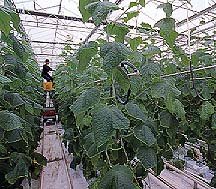|
Agriculture: Green, White and Blue Revolution
by Wei Ling
in "Beijing Review", 42(1999), n. 5, pp. 8-11
In the of 1998, Anhui Province in east China bred a variety of ternary hybrid rice. The result has drawn the attention of rice experts as the highyield crop has a strong resistance to disease and is of fine quality. It could very possibly become a new substitute variety in China's rice producing areas.
On October 28, the famous rice expert Yuan Longping, known as the "Father of Rice", wrote a letter to the Anhui Academy of Agricultural Sciences, acclaiming it as a new breakthrough in hybrid rice breeding. He believes that it is the ideal variety to replace the traditional one in the Yangtze River valley. The research is at the forefront of its field.
Over the past two decades, Chinese agro-scientists have made successive breakthroughs in the breeding of new varieties of rice and wheat, greatly promoting the stable growth of China's grain output. Now, China's total grain output has reached 450 million tons making it the largest grain producer in the world, and basically solving the food problem of 1.2 billion people.
Scientific and technological progress has become a mighty force propelling agricultural development. According to experts, during the period between 1986 and 1990, the contribution rate of scientific progress stood at 27 percent. In the 1991-95 period, the rate was up to 34 percent, and in 1997 to 40 percent. Over the past few years, efforts were focused on popularizing fine varieties of hybrid rice, hybrid maize, high-yield and fine quality wheat, and the farming technology of plastic film covers.
Scientific and technological progress has also been applied to aquaculture. This sector has risen to a new level in relation to breeding fish from ponds to large and medium-sized waters, and from shallow seas to beaches.
"Green Revolution"
 In the early 1970s when Chinese agro-scientists found wild rice with abortive pollen on Hainan lsland, they never thought that the hybrid rice they would develop based on it 20 years later would cover 130 million hectares, increasing rice output by 240 billion kg at a rate of 14-30 percent. This variety of hybrid rice has not only brought China's grain output onto a new level, but has also been introduced to many other countries and regions in the world. In the early 1970s when Chinese agro-scientists found wild rice with abortive pollen on Hainan lsland, they never thought that the hybrid rice they would develop based on it 20 years later would cover 130 million hectares, increasing rice output by 240 billion kg at a rate of 14-30 percent. This variety of hybrid rice has not only brought China's grain output onto a new level, but has also been introduced to many other countries and regions in the world.
lt is no wonder that Yuan Longping, an agro-scientist who made tremendous contributions to the development of the country's hybrid rice, won the State special award for scientific and technological progress. Yuan has won more awards than scientists engaged in the research of atomic and hydmgen bombs.
Agro-scientists estimate that the creation of new varieties (each time on a large scale) over the past few years has increased the total grain output by at least 10 percent. In addition to hybrid rice, many improved cotton varieties featuring long cotton fibers, pure white color and high yield have brought in enormous economic results once they were widely popularized in the country. The output increase rate was registered between 10-20 percent. The past few years have also seen an increase in the output of peanuts (the growth rate being around 25 percent) because fine varieties containing a high proportion of oil have been widely introduced.
From 1992 to 1997. Chinese agro-scientists have developed 207 new varieties of grain crops, 184 economic crops and 82 vegetables. New varieties of six major crops (rice. wheat. maize, barley. millet and sorghum) have been popularized and cover about 100 million hectares, which led to a total grain output increase of 31.9 billion kg. with economic results reaching 50.1 billion yuan.
Since the late 1980s the second ‘green revolution' represented by trans-genosis plant, has unfolded throughout the country. A batch of trans-genosis plants have been developed, including the anti-verticillium wheat, rice free from weed killers and the disease-resistant potato. They have entered the stage of field experimentation and demonstration.
The most outstanding development is the breeding and popularization of pest-resistant cotton. Several years ago, cotton bollworm posed a serious threat to cotton growth in China. ln north China, cotton-producing areas hit by a plague of cotton bollworm had their total output reduced by two thirds; some farmers even suffered a total crop failure. The Chinese Academy of Agricultural Sciences listed the anti-bollworm research at the top of its agenda. Now an important breakthrough has been made in this field. Agro-scientists have developed 12 fine varieties of bollworm-resistant cotton. Last year when a plague of cotton bollworm attacked these new varieties of cotton, the crops withstood the test. These new varieties have the same bollworm-resistance as those developed by foreign countries. As the quality of the cotton fiber and harvest are ensured with the perhectare grinned cotton output reaching 1,500 kg, these varieties are commonly favored by cotton farmers.
In Shandong, farmers even lined up to acquire the seeds. To ensure the sustainable development of China's agriculture, the Chinese Govemment has made the research of agricultural biological technology a priority. Many scientists have joined together to conduct research on rice genomo, hybrid advantages and trans-genosis stability.
White Agriculture
China's per-capita arable land will be reduced to 0.08 hectares after 30-40 years, while the per-capita water resources will decrease by one third. By then, the country's "green agriculture" centering on water and land will reach its full capacity, imposing the grim challenge of supplying a population of more than 1 billion with food.
Prof Bao Jianzhong, a research fellow of the Chinese Academy of Agricultural Sciences, has proposed the development of "white agriculture" after years of research. Prof. Bao, praised by his overseas peers as the father of "white agriculture", advocates the separation of grain consumption by human beings and livestock as a measure to relieve grain shortages. Prof. Bao's research has aroused the interest of the Chinese Government.
Accordillg to Prof. Bao, the earth's biological resources can be classified into three categories -plants, animals and microbes. Plants are producers, animals are consumers, and microbes are decomposers and restorers. The three categories of biological resources constitute the benign cycle of the geo-biosphere.
Traditional agriculture is limited to the utilization of plants and animals, which produces adverse effects on the ecological environment and results in a huge waste of resources. For instance, it takes a year for a stem of corn to mature. But only the kernels of corn are used, while 50-60 percent of the product is simply thrown away.
Traditional agriculture is not scientific in terms of grain utilization und distribution, pointed out Prof. Bao. Currently, the world's grain distribution is as follows: 42.3 percent for human consumption, 42.9 percent for animal feed, and 14.8 percent the industrial and seed purposes. lt is evident that the grain consumption by humans and livestock is almost equal in amount. According to the statistics of the US World Watch lnstitute, 10 percent of grain saved from the world's livestock feed is enough cereal supply for about 90 million people for 28 months.
ln 1995, grain used as livestock feed in China was 140 billion kg. accounting for 30 percent of the country's total grain production. If the present livestock grain consumption is reduced by 50 percent, China will be able to save 70 billion kg of grain a year. The only way to reduce the waste of resources and separate grain consumption by humans and livestock is to develop "white agriculture", stated Prof. Bao.
"White agriculture" refers to an industrialized agriculture that uses microbes. The production is carried out in factories without environmental pollution, where the workers wear white clothes, hence the name. Compared to traditional green agriculture, "white agriculture" adopts an entirely different production process. It relies on artificial energies and is not limited by weather or season. As an industry based on microbial fermentation engineering, production can be carried out on a mass scale all the year round in factories, thus saving land, water and other resources with no damage to the environment.
Prof. Bao is extremely optimistic about the development of microbial resources. It is estimated that through microbial fermentation engineering, unicellular protein produced by 2 percent of the world's petroleum output can support 2 billion people for one year. In China, if 20 percent of the 500million-ton stalks are transformed into feed through microbial fermentation, the country can save about 40 billion kg of feed a year, or one third of the present total.
The microbial industry is effective in saving land resources. For instance, a microbial plant with an annual production capacity of 100,000-ton unicellular protein can produce soya-bean protein equivalent to the annual output of 120,000 hectares of land. Up till now, unicellular protein production has formed on a large scale in the food and pharmaceutical industries. China now boasts 50-plus such plants, with the output reaching about 10,000 tons in 1990, a large proportion of which were pharmaceuticals and edible yeast. However, little unicellular protein is used as feed.
China recently held its first national symposium on "white agriculture" in Jinan, Shandong Province. Nine white agriculture research and development institutes across the country participated in the symposium, which will be held annually in the future. Moreover, the Center for Agriculture and Biosciences International will hold a symposium on "white agriculture" in Beijing in May 1999, which will be an opportunity for China to cooperate with the rest of the world in the field.
"Blue Revolutlon"
In 1991, Shandong, China's largest marine products base, put forward the concept of "building a Shandong on the sea". Many coastal provinces responded with their plans for the development of marine farming and the breeding of fine marine biological fine varieties, thus igniting a "blue revolution" in China.
China's coastline stretches 18,000 km. There are 140 million hectares of offshore continental shelters within the water depth of 200 meters, where there are some 20,000 species of marine life, including 3,000 species of fish. About 10 million hectares of shallow sea is suitable for the development of aquaculture in the years to come.
Over the past decade, China's marine sector has developed at a high speed. The national aquatic products output reached 8.24 million tons in 1996 and jumped to 28 million tons in 1996. Of it, the output through sea farming amounted to 7.64 million ton. ln 1996, the total output value of sea fishery as 65 billion yuan, an increase of 26.64 billion yuan over 1992, registering an annual increase of 14 percent. Nowadays China's marine products output leads the world, accounting for more than 40 percent of the world’s total.
The total area of shallow sea acquaculture has expanded from 114.000 hectares in 1996 to 167.000 hectares in 1997. Considerable progress has also been made in beach aquaculture, with the area expanding from 533.000 hectares in 1996 to 589.600 hectares in 1997.
Shallow sea aquaculture occupies the most important position in marine aquaculture, with fan shells, mussels, oysters and sporeling being the major products. So far, China has established the world's largest breeding farm of marine algae, prawn and fan shell.
Prawn breeding has develop rapidly due to breakthroughs made since the late 1970s in artificial breeding technology. ln the early hectares of prawn ponds in the country, with an annual breeding capacity of 100 billion prawns. In 1993, prawn diseases inflicted major prawn-producing countries in Asia, causing heavy losses. The Ministry of Agriculture made research into prawn diseases a key project for three consecutive years. In 1997, the total output of prawn in the country's coastal areas reached 100.000 tons. lts output and economic results have been restored to a certain extent.
In the early 1990s, China made the strategic decision of "turning the big marine-resources country into a strong marine-economic one", and began implementing its program for "invigorating the marine economy through science and technology". Marine economic development has become a common concern, while marine biotechnology is favored because it is the foundation for the development of marine industries. ln the field of marine bio-technology, research has heen conducted into seaweed monoploid breeding and fish genetic engineering breeding. In cooperation with their American counterparts, Chinese scientists have successfully bred triploid and tetraploidy prawns, followed by the tetraploidy penaeus chinensis. Prawns bred in such a way are superior to ordinary ones in terms of color. transparency and plumpness, being about 60 percent heavier than their predecessors. Progress has also been made in the breeding of the multi-ploid fan shell and abalone, as well as in marine medicines.
According to the Ministry of Agriculture, in 1997, the contribution rate of scientific and technological progress in aquaculture came to as much as 46 percent.
The development of China's marine fishery in the years to come will he focused on the scientific breeding of fine varieties and fries, and maintaining a better aquacultural environment, and preventing and combating pollution as well as various diseases. Efforts will also be made to develop a procession of marine products, including the development of marine medicines.
|





